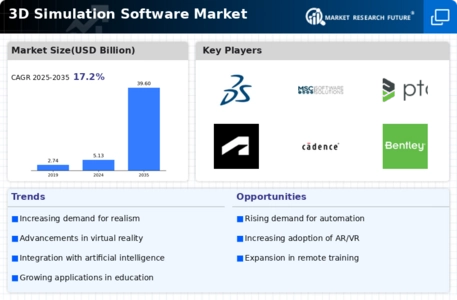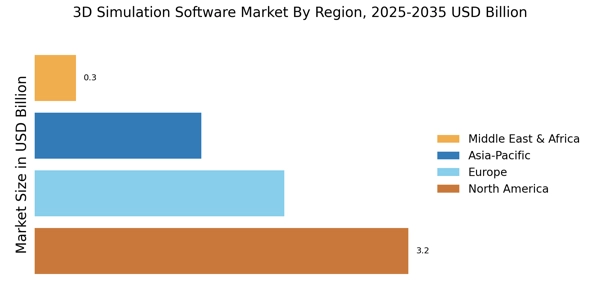Advancements in Technology
Technological advancements play a pivotal role in shaping the 3D Simulation Software Market. Innovations in graphics rendering, processing power, and cloud computing are enhancing the capabilities of simulation software, making it more accessible and efficient. For instance, the integration of real-time rendering technologies allows for more dynamic and interactive simulations, which are crucial for industries such as gaming, architecture, and manufacturing. The market is projected to grow at a compound annual growth rate (CAGR) of 12% over the next few years, driven by these technological improvements. As companies seek to leverage cutting-edge technology to improve their operational efficiency, the demand for sophisticated 3D simulation tools is expected to rise.
Rise of Smart Manufacturing
The concept of smart manufacturing is gaining traction, significantly impacting the 3D Simulation Software Market. As industries adopt Industry 4.0 principles, the need for simulation software that can model complex manufacturing processes becomes increasingly apparent. This trend is supported by data indicating that manufacturers utilizing simulation tools can achieve up to 30% improvements in efficiency and productivity. The market for manufacturing simulation software is expected to grow at a CAGR of 10% in the next few years, driven by the need for optimization and cost reduction in production processes. As companies strive to enhance their operational capabilities, the demand for 3D simulation software tailored for manufacturing applications is likely to rise.
Growing Demand in Healthcare
The healthcare sector is increasingly recognizing the value of 3D simulation software, which is becoming a critical component in medical training and surgical planning. The 3D Simulation Software Market is witnessing a significant uptick in demand as healthcare professionals utilize these tools for virtual surgeries and patient simulations. This trend is supported by data indicating that the use of simulation in medical training can reduce errors and improve patient outcomes. The market for healthcare simulation software is anticipated to grow at a CAGR of 14% in the coming years, reflecting the industry's commitment to enhancing training methodologies and patient care through advanced simulation technologies.
Expansion of the Gaming Industry
The gaming industry is a major driver of growth within the 3D Simulation Software Market. As gaming technology evolves, there is an increasing demand for realistic and immersive gaming experiences, which rely heavily on advanced simulation software. The market for gaming simulation software is projected to expand significantly, with estimates suggesting a growth rate of 18% over the next few years. This expansion is fueled by consumer expectations for high-quality graphics and interactive gameplay, prompting developers to invest in sophisticated 3D simulation tools. As the gaming landscape continues to evolve, the demand for innovative simulation software is likely to remain robust.
Increasing Adoption in Education and Training
The 3D Simulation Software Market is experiencing a notable surge in adoption within educational institutions and training programs. This trend is driven by the need for immersive learning experiences that enhance student engagement and retention. According to recent data, educational institutions are increasingly integrating 3D simulation tools into their curricula, with a projected growth rate of 15% in the next five years. These tools allow for realistic scenarios that prepare students for real-world applications, particularly in fields such as engineering, healthcare, and aviation. As educational institutions recognize the value of experiential learning, the demand for 3D simulation software is likely to continue its upward trajectory, thereby expanding the market further.


















Leave a Comment